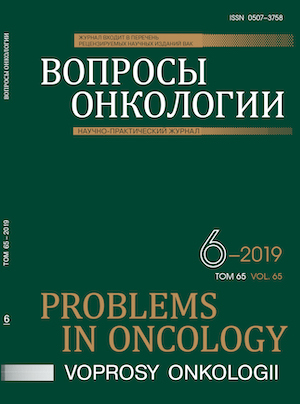Аннотация
В данной статье описано редкое клиническое наблюдение хирургического лечения метатипического рака кожи (МТРК) передней грудной стенки с закрытием дефекта множественными перемещёнными лоскутами. МТРК - довольно редкое злокачественное новообразование (ЗНО), частота встречаемости которого составляет всего лишь 5 % от всех немеланомных ЗНО кожи. основным методом лечения остаётся по-прежнему хирургический в виде широкого иссечения образования, но из-за трудностей закрытия обширных дефектов кожи после удаления опухоли возникает необходимость использования перемещенных лоскутов.Библиографические ссылки
Jung GW, Metelitsa AI, Dover DC, Salopek TG. Trends in incidence of nonmelanoma skin cancers in Alberta, Can ada, 1988-2007. British Journal of Dermatology. 2010 Sep;163(1):146-154. DOI: 10.111Vj.1365-2133.2010.09809.x.
Tarallo M, Cigna E, Fino P, et al. Metatypical basal-cell carcinoma (MTC) or basosquamous carcinoma (BSC): surgical therapy. Ann Ital Chir. 2011; 82:389-94.
Злокачественные новообразования в России в 2017 году (заболеваемость и смертность). Под ред. А.Д. Каприна, В.В. Старинского, Г.В. Петровой. Москва 2017 г., 249с. [Malignant neoplasms in Russia in 2014 (morbidity and mortality). A.D. Kaprin, V.V. Starinsky, G.V. Petrov. Moscow 2016, 249с. (In Russ.)].
Kazantseva IA, Khlebnikova AN, Babaev VR. Immunohistochemical study of primary and recurrent basal cell and metatypical carcinomas of the skin. Am J Dermatopathol 1996; 18: 35-42.
Wollina U, Tchernev G. Advanced basal cell carcinoma. Wien Med Wochenschr. 2013;163:347-53. DOI: 10.1007/s10354-013-0193-5
Surdu S, Fitzgerald EF, Bloom MS, Boscoe FP, Carpenter DO, Haase RF, et al. Occupational exposure to ultraviolet radiation and risk of non-melanoma skin cancer in a multinational European study. Apr 24;2013 PLoS One. 8(4) e62359. DOI: 10.1371/journal.pone.0062359
MacCormac H. The relation of rodent ulcer to squamous cell carcinoma of the skin. Arch Middlesex Hosp. 1910;19:172-83. DOI: 10.1016/s0140-6736(01)57981-7
Martin RC 2nd, Edwards MJ, Cawte TG, et al. Basosquamous carcinoma: analysis of prognostic factors influencing recurrence. Cancer. 2000; 88(15):1365-9.
Garcia C, Poletti E, Crowson AN. Basosquamous carcinoma. J Am Acad Dermatol. 2009;60:137-43. DOI: 10.1016/j.jaad.2008.09.036
Surdu S, Fitzgerald EF, Bloom MS, Boscoe FP, Carpenter DO, Haase RF, et al. Occupational exposure to arsenic and risk of nonmelanoma skin cancer in a multinational European study. Int J Cancer. 2013 Nov; 133 (9): 2182-2191. DOI: 10.1371/journal.pone.0062359
Wu S, Han J, Li WQ, Li T, Qureshi AA. Basal-cell carcinoma incidence and associated risk factors in U.S. women and men. Am J Epidemiol. 2013;178(6):890-897. DOI: 10.1093/aje/kwt073
Varga E, Korom I, Rask Z, Kis E, Varga J, Ol h J, Kern ny L. Neglected basal cell carcinomas in the 21st century. J Skin Cancer. 2011; 2011:392151. DOI: 10.1155/2011/392151
Kazantseva IA, Bogatyreva II, Vavilov AM, Parshikova SM. Differential diagnosis of basalioma and metatypical skin cancer. Arkh Patol. 1983;45:35-9.
Aldred WV, Ramirez VG, Nicholson DH. Intraocular invasion by basal cell carcinoma of the lid. Arch Ophthalmol. 1980;98:1821-2. DOI: 10.1001/ar-chopht.1980.01020040673016
Leibovitch I, Huilgol SC, Selva D, Richards S, Paver R. Basosquamous carcinoma. Treatment with Mohs micrographic surgery. Cancer 2005;104:170-5. DOI: 10.1002/cncr.21143
Smith V, Walton S. Treatment of facial Basal cell carcinoma: a review. J Skin Cancer. 2011:1-7. Article ID.380371. DOI: 10.1155/2011/380371
Bowman PH, Ratz JL, Knoepp TG, et al. Basosquamous carcinoma. Dermatol Surgery. 2003;29:830-2. DOI: 10.1097/00042728-200308000-00013
Tarallo M, Cigna Е, Frati R, Delfino S, Innocenzi D, Fama U, Corbianco A, Scuderi N. Metatypical basal cell carcinoma: a clinical review. J Exp Clin Cancer Res. 2008;27:65. DOI: 10.1186/1756-9966-27-65
Dhouib H, Mnejja M, Ayadi L, Hammami B, Boudawara T, Ghorbel A. Cutaneous basosquamous carcinoma. Ann. Otolaryngol Chir Cervicofac. 2009; 126: 25-8.

Это произведение доступно по лицензии Creative Commons «Attribution-NonCommercial-NoDerivatives» («Атрибуция — Некоммерческое использование — Без производных произведений») 4.0 Всемирная.
© АННМО «Вопросы онкологии», Copyright (c) 2019
